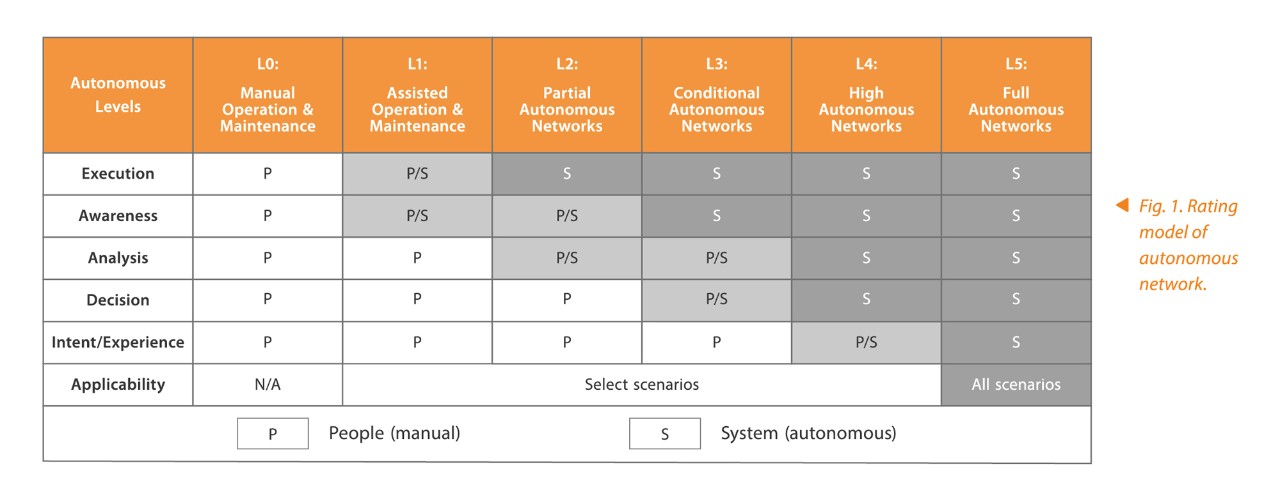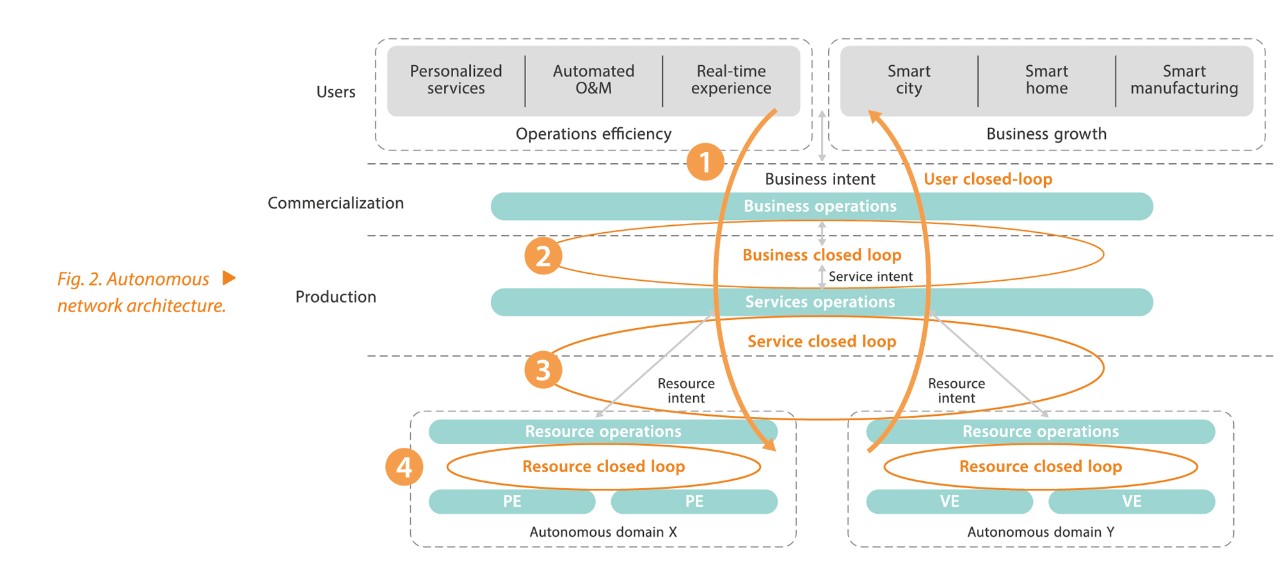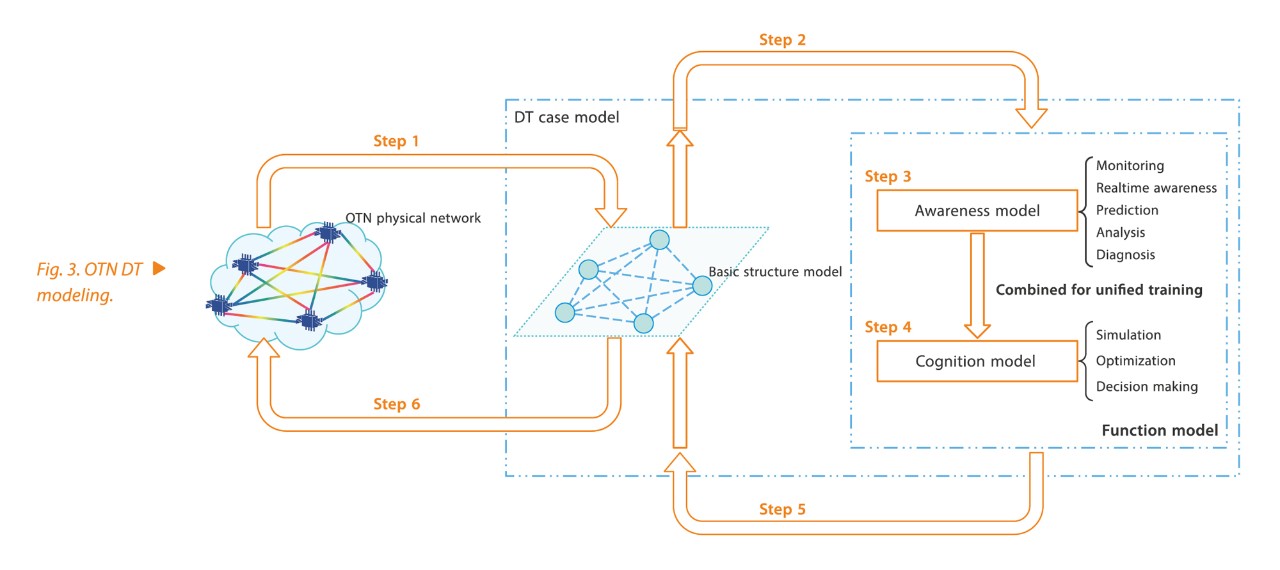Perspective of Autonomous Optical Transport Network
Digital economy is becoming the key force in reorganizing global resources, reshaping economic structure, and transforming global competitive landscape. Driven by a direct investment worth $6.8 trillion in digital transformation in 2020–2023, 65% of global GDP is expected to come from the digital economy, where products, services and experiences are digitally enhanced. Telecom operators, as the pioneers, accelerate their digital transformation through autonomous networks and share the benefits from the digital economy. On the one hand, autonomous networks can give rise to new service models and ideas, bringing new revenue opportunities to operators; on the other hand, digital O&M can help operators cut costs and increase efficiency.
Development of Autonomous Network
Driving Force
Major operators have been engaged in digital transformation in recent years, and the acceleration of digitization has increased significantly since 2021. As the digitization grows, the industry increasingly relies on these all-digital operations to add business value. An important part of digital transformation is that automated O&M can meet the needs of the environment at a growing rate. Lack of automation can cause bottlenecks in provisioning/operations and increase the possibility of human errors, which may lead to system downtime and affect normal operation. This may eventually delay the delivery of services to the line of business (LOB) and reduce the availability of services. Meanwhile, the network needs to be more responsive, and automation tools are needed to ensure that the network meets high standards, including reducing errors and support costs, increasing uptime and enhancing agility.
History of Development
To address these challenges, Deutsche Telekom took the lead in launching the NSM workshop in Bonn as early as December 2016, with the theme “Network and Service Management of Future Networks: ZERO TOUCH”, which started the process of network automation. Then automation and SD-WAN, two topics in the SDN Congress held in the Netherlands in 2017, marked that autonomous networks officially entered the pre-research phase. ETSI established the Zero touch network & Service Management (ZSM) group in 2018, which started the process of network intelligence. Subsequently, there are all kinds of research on network intelligence. For example, GSMA released the AI & Automation: An Overview research report, followed by the AI in Network Use Cases in China white paper at the end of 2019. ETSI published the Autonomous Networks, Supporting Tomorrow’s ICT Business white paper, 3GPP SA5 published the Study on Concept, Requirements and Solutions for Levels of Autonomous Network, ITU-T released the Y.3173: Framework for Evaluating Intelligence Levels of Future Networks Including IMT-2020, and TM Forum set up the Autonomous Networks Program.
The 2022 Gartner® Hype Cycle™ for CSP Networks Infrastructure shows that the network AI and automation is in the “trough of disillusionment” and is expected to reach plateau of productivity within two years. In recent years, Vodafone, MTN, China Mobile, China Telecom, China Unicom, AIS and Indosat have come up with their 2025 autonomous network strategies, indicating that autonomous networks are about to enter a new stage of large-scale trials and systematic deployments for operators.
Standard Definition
At present, the industry generally agrees with TMF’s definition of autonomous network. The TMF Autonomous Networks Program defines self-serving, self-fulfilling, and self-assuring (Self-X) capabilities from a network perspective, and zero wait, zero touch and zero trouble (Zero-X) experiences from the perspective of vertical industries and users. This makes it possible to “leave complexity to vendors and give simplicity to customers”. The program also specifies core concepts and grading standards of single-domain autonomy, hierarchical closed-loop, and intent-driven to achieve and measure customer experience and SLAs, guide the automation and intelligence of networks and services, evaluate the value and advantages of autonomous network services, and guide operators and vendors to carry out intelligent upgrade. L5 is the ultimate goal of telecom network evolution, where the system supports full-scenario closed-loop intelligence for multi-service, multi-domain and full life cycle (Fig. 1).

Network Architecture and Key Technology Analysis
Network Architecture
The autonomous optical network uses the autonomous network framework set up by the TM Forum, which is divided into three layers: resource operations layer, service operations layer and business operations layer, and four closed-loops: user closed-loop, business closed-loop, service closed-loop and resource closed-loop (Fig. 2).

Based on the basic principle of closed-loop correlation and interaction at different layers shown in Fig. 2, the autonomous network architecture can
be summarized as follows: based on the autonomous domain, the user closed-loop serves as the main line of connecting business, service and resource closed loops; driven by the business, the business, service and resource closed
loop collaboration mechanism is used to solve the interaction problems between the adjacent layers, and finally digital closed-loop automatic intelligent business, service and resource operations can be realized, thus providing the best user experience, maximum resource utilization and full lifecycle automatic and intelligent operations.
Key Technologies
In the full lifecycle of network planning, construction, maintenance and optimization, an autonomous network is made intelligent through network awareness, automation, intent-driven, pre-event simulation and post-event verification. To obtain these intelligent capabilities, four key technologies are needed, including capability exposure, digital twin, intent based network (IBN) and AI.
Capability Exposure
The three-layer four-loop autonomous optical network requires the capability to be exposed from the bottom up for agile collaboration between NE and business layers. Capability exposure at the resource layer is the basis of all capability exposure and also a key factor for improving the OTN closed-loop autonomous level. Based on Self-X, the OTN capability exposure at the resource layer are divided into provisioning, awareness, maintenance and optimization.
- —Provisioning: Service provisioning is the primary requirement of automation. Provisioning should be intelligent, simple and agile while addressing the original needs of users qualitatively and quantitatively.
- —Awareness: Network awareness is the most fundamental and important capability. Awareness of OTN resources and usage, transport and service performance quality, and potential risks can support effective resource allocation, visual service quality, and risk warning, thereby increasing operating revenue and ROI.
- —Maintenance: Network maintenance is the most technically differentiated capability, including inspection, diagnosis, testing, and repair. By encapsulating technology differences in a single domain, the capability is exposed to the upper layer for cross-domain coordination, so as to achieve end-to-end maintenance automation with low cost and scalability.
- —Optimization: Network optimization is always a single-domain function. End-to-end optimization is an advanced embodiment of autonomous capability. On the basis of awareness and maintenance capabilities, the optimization capability can be exposed to optimize resources and quality from the perspective of the whole network.
Capability exposure is the cornerstone of autonomous network. Capability exposure at the resource layer helps to evolve OTN to a higher closed-loop autonomous level.
Digital Twin
Professor Michael Grieves first put forward the concept of digital twin (DT) at the University of Michigan in 2003, NASA first applied the DT concept in 2012, and China Mobile released the Digital Twin Network (DTN) White Paper in 2021, introducing DT into telecom networks. DT is an important means to achieve network intelligence and automation. It helps the autonomous network obtain topology perspective and traffic holography, trace faults back to the past, simulate and verify network configuration and optimization in digital twins, so it is the core of autonomous network L4. In the autonomous OTN field, DT cases have three types of models (Fig. 3):

—Basic structure model: Based on physical object features such as structure (ROADM optical cross-connect matrix), status (optical fiber health) and performance (optical power and OSNR) , a twin abstract mathematical model is built as the modeling basis for DT network awareness and cognition.
—Awareness model: The data is sampled based on the features of OTN physical objects obtained from the basic structure model to train and generate a DT awareness model to complete awareness functions such as optical performance prediction, optical health analysis and fiber break fault diagnosis.
—Cognition model: According to changed features such as OTN performance, status and fault root causes obtained from the awareness model, a DT cognition model is trained and generated to complete cognitive functions such as optical resource planning simulation, optical performance optimization design, and fault recovery decision-making.
DT can be used to trace history, know the present and predict the future. It provides a digital presentation and decision-making basis for the autonomous network, thus promoting the optical network to reach autonomous network L4.
Intent Based Network
ONF released the Intent: Don`t Tell Me What to Do! Tell Me What You Want in 2015, which came up with the intent concept. The most important technologies of intent are intent translation and assurance. The former translates user intents into network configuration and monitoring configuration, while the latter monitors and assures user intents.
Each layer of the autonomous network architecture can be driven by an intent. For example, the service operation layer uses resource intents to send requirements and constraints on network resources and performance to the resource operation layer.
Take service provisioning of an enterprise OTN private line for example. Based on the basic information (such as source and destination nodes), user SLAs, application scenarios, and user preference of the OTN private line to be provisioned, the intent is parsed with natural language processing (NLP) into the optical/electrical network resource configuration solution required by the private line and deployed in the network.
After service provisioning, the system monitors the SLA of the intent according to the requirements and corrects the deviation manually or automatically to ensure that network management resources meet the intent requirements. The intent-based network can not only simplify O&M, but also improve high availability of services to achieve the high-level goal of an autonomous network.
AI
The network makes its own decisions based on analysis. Due to the complexity of OTN networks and services, there is a lack of logical methods for the analysis of network faults and performance quality, especially for hidden troubles of the system physical features, so it is necessary to introduce AI to define and determine. As a major enabling technology for an autonomous telecom network, AI lays a solid foundation for setting up an autonomous OTN ecological industry chain. Typical applications of AI in AN OTN are as follows:
—OTN health status awareness: Time series with deep learning, and GAN algorithms are used to perceive the health status of an OMS link through performance time series such as OSNR and optical power attenuation, and improve the agility, precision and generalization of awareness.
—OTN service recovery cognition: The OTN link performance awareness algorithm model can be combined with the private line service optimization algorithm model. Based on the awareness of OTN link performance degradation, the private line services carried over the OTN link are learned based on the objectives like latency, cost, and bandwidth utilization to generate an optimization solution and form the cognition of service recovery.
—Cross-domain optical performance analysis: Take the prediction of OTN NE performance (OSNR, optical power) for example. The horizontal federated machine learning (HFML) can be used to build a cross-domain OTN NE performance prediction model involving multiple vendors to avoid model overfitting caused by partial training of a single vendor, improve the generalization of the model, and solve the problem of sample data privacy leakage in centralized training.
Conclusion
In the future, autonomous OTN will evolve towards digital, intelligent, full-lifecycle Self-X O&M, building an efficient and reliable all-optical basic network, and enabling Zero-X experience. It will rely on capability exposure, intent-based network, DT, and AI technologies, and will be combined new application scenarios of future networks to improve OTN autonomous levels. In terms of industrial operation, it vertically connects business-operation (B-O) domains and drives service operators to schedule and enable OTN resources of equipment vendors at the OTN resource layer, so as to gradually create a win-win situation for service operators and equipment vendors. It is generally agreed in the industry that the autonomous OTN will evolve in three phases and is expected to reach autonomous network L4 by 2025.